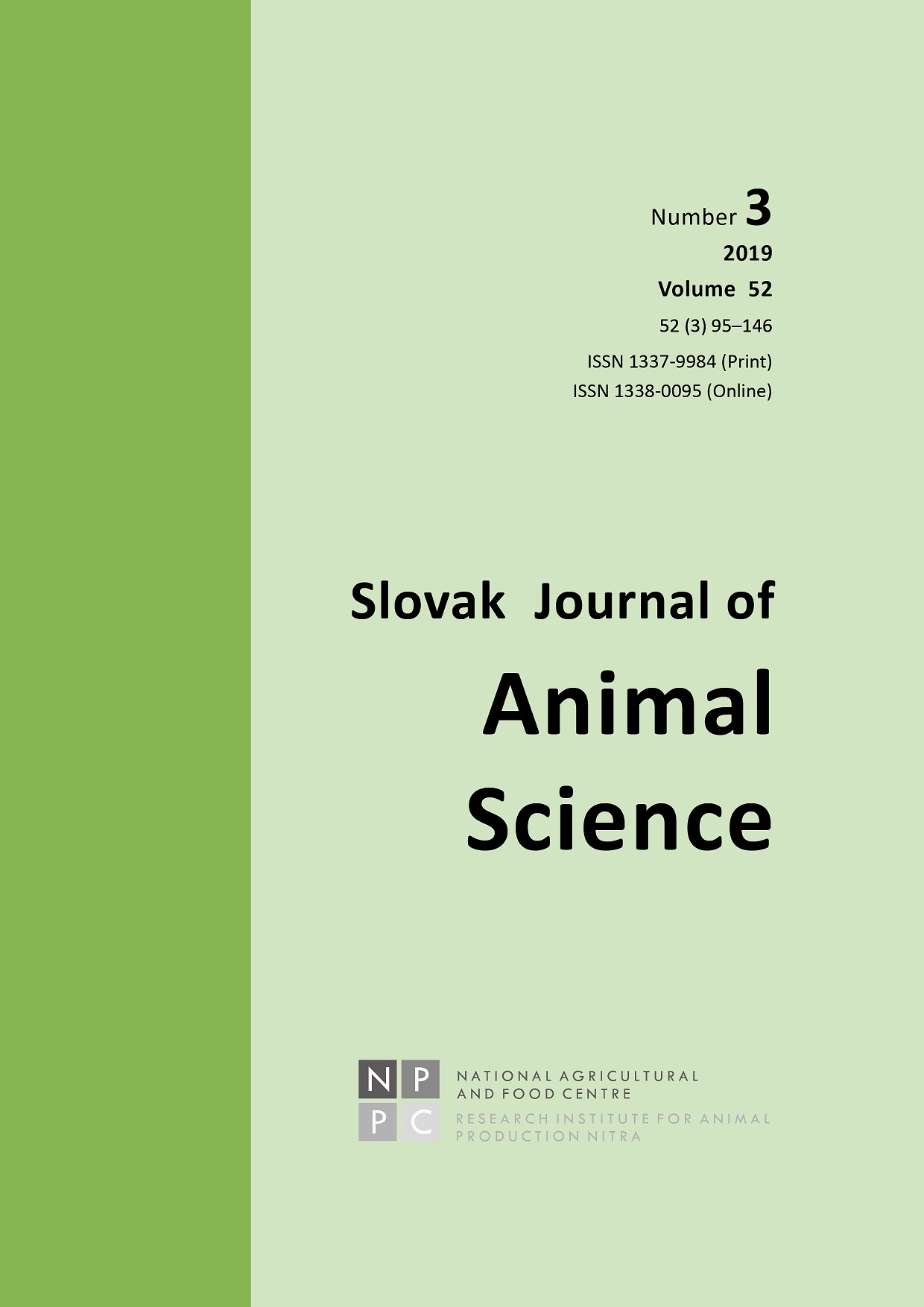UTILIZATION OF CYTOCHROME B – MITOCHONDRIAL DNA IN BROILER RABBIT SELECTION
Keywords:
polymorphism, cyt b, rabbit, reproductionAbstract
Cytochrome b haplotypes (GenBank OCU07566, NCBI, USA) of mitochondrial DNA (mtDNA) were described in meat lines of rabbits – cyt b 430 and cyt b 306. The haplotype cyt b 430 represents 571A (190Threonine-T)+877G(292Alanine -A). Haplotype cyt b 306 with polymorphism A571G mtDNA-cell line LEU-RAB is registered as BioSample: SAMN03701526; Sample name: cyt b O.C. (Model organism or animal sample from Oryctolagus cuniculus), in NCBI, USA. The vitality of offspring of the cyt b 306 haplotype, represented by the average number of weaned youngs at 42 days of age, was significantly higher compared to the haplotype cyt b 430 ( ẍ = 7.00 vs. ẍ = 5.69, t (0.01) = 2.91++). These results are confirmed also by the immunogenetic results determined using flow cytometry. Haplotype cyt b 306 is characterized by a significant increase (P = 0,041+ to P = 0,049+) of the flow cytometric parameters at the frequency of T lymphocytes, which results in activation of lymphocytes of the type pT2 and CDS4 (pT2 = 22.02 ± 4.45 % and CD4 = 17.08 ± 3.43 %), compared to the cyt b 430 haplotype, which is represented by significantly lower values of the flow cytometric parameters in activation of lymphocytes of the pT2 and CD4 type (pT2 = 15.32 ± 6.11 % and CD4 = 11.8 ± 4.83 %). Meanwhile, in the reproduction parameters such as the average number of live-born kits, no differences (8.45 vs. 8.00) were determined between the studied haplotypes (cyt b 306 vs. cyt b 430). Similarly, production parameters represented by carcass value (carcass without the head and skin) of both haplotypes (cyt b 306 vs. cyt b 430) were not influenced by the targeted selection and remained on the same level of 54 % (54.41 vs. 54.26).
References
Avise, J. C., Arnold, J. & Ball, R. M. (1987). Intraspecific Phylogeography – the mitochondrial – DNA Bridge between Population – Genetics and Systematics. Annual Review of Ecology and Systematics, 18, 489–522.
Ballard, J. W. O. & Whitlock, M. C. (2004). The Incomplete Natural History of mitochondria. Molecular Ecology, 13, 729–44.
Brand, M. D. (1997). Regulation Analysis of Energy Metabolism. Journal of Experimental Biology, 200, 193–202.
Corpet, F. (1988). Multiple Sequence Alignment with Hierarchical Clustering. Nucleic Acids Research, 16(22), 10881–10890.
Cummins, J. (1998). Mitochondrial DNA in Mammalian Reproduction. Review of Reproduction, 3, 172–182.
Diez-Sanchez, C., Ruiz-Pesini, E. & Lapen, A. C. (2003). Mitochondrial DNA Content of Human Spermatozoa. Biology of Reproduction, 68, 180–185.
DOWLING, D. K., FRIBERG, U. & LINDELL, J. (2008). Evolutionary Implications of Non-neutral Mitochondrial Genetic Variation. Trends in Ecology & Evolution, 23(10), 546–554.
Faldyna, M., Levá, L., Knötigová, P. & Toman, M. (2001). Lymphocyte subsets in peripheral blood of dogs – a flow cytometric study. Veterinary Immunology and Immunopathology, 82, 23–37.
Finkelman, F. D., Holmes, J., Katona, I. M., Urban, J. F., Beckmann, M. P., Park, L. S., Schooley, K. A., Coffman, R. l., Mosmann, T. R. & Paul, W. E. (1990). Lymphokine control of in vivo immunoglobulin isotype selection. Annual Review of Immunology, 8, 303–333.
Gemmell, N. J., Metcalf, V. J. & Allendorf, F. W. (2004). Mother's Curse: the Effect of mtDNA on Individual Fitness and Population Viability. Trends in Ecology & Evolution, 19(5), 238–244.
Graeber, M. B. & Muller, U. (1998). Recent Developments in the Molecular Genetics of Mitochondrial Disorders. Journal of the Neurological Sciences, 153, 251–263.
Kelso, A., Troutt, A. B., Maraskovsky, E., Gough, N. M., Morris, L. Pech, M. H. & Thomson, J. A. (1991). Heterogeneity in lymphokine profiles of CD4+ and CD8+ T cells and clones activated in vivo and in vitro. Immunological Reviews, 123, 85–113.
Kroemer, G., Dallaporta, B. & Resche, R. (1998). The Mitochondrial Death/Life Regulator in Apoptosis and Necrosis. Annual Review of Physiology, 60, 619–42.
Miller, J. F. A. P. (1972). Lymphocyte interactions in immune responses. International Review of Cytology, 33, 77–130.
Minarovic, G., Trakovicka, A., Rafayova, A. & Lieskovska, Z. (2010). Animal Species Identification by PCR—RFLP of Cytochrome b. Scientific Papers: Animal Science and Biotechnologies, 43, 296–299.
Mosmann, T. R. & Coffman, R. L. (1989). Th1 and Th2 cells: different patterns of lymphokine secretion lead to different functional properties. Annual Review of Immunology, 7, 145–173.
Nossal, G. J. V. (1997). Host immunobiology and vaccine development. Lancet, 350, 1316–1319.
Nossal, G. J. V., Cunnigham, A., Mitchell, G. F. & Miller, J. F. A. P. (1968). Cell To Cell Interaction In The Immune Response. III. Chromosomal marker analysis of single antibody-forming cells in reconstituted irradiated or thymectomized mice. The Journal of Experimental Medicine, 128, 839–853.
Parkanyi, V., Ondruska, L. & Vasicek, D. (2016). The Cytochrome b Polymorphism of Meat Lines Rabbits. Journal of Life Sciences, 10, 16–20. http://www.davidpublisher.org/Public/uploads/Contribute/5715c9fe4aa3e.pdf
Parkányi, V., Ondruška, L., Vašíček, D., Jurčík, R., Hanusová, E., Vašíček, J. & Baláži, A. (2015). Model organism or animal sample from Oryctolagus cuniculus./ Oryctolagus cuniculus (rabbit). http://www.ncbi.nlm.nih.gov/biosample/3701526, and http://www.ncbi.nlm.nih.gov/bioproject/284428
Wei, Y. H. (1998). Oxidative Stress and Mitochondrial DNA Mutations in Human Aging. Proceedings of Society Experimantal Biology and Medicine, 217, 53–63.
Zink, R. M. & Barrowclough, G. F. (2008). Mitochondrial DNA under siege in avian phylogeography. Molecular Ecology, 17(9), 2107–2121.

